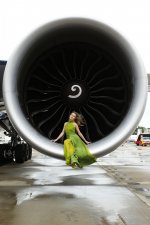We have quite a few Canadian geese in the area around DIA. So a "Bird strike" is a little closer to a Turkey that can get high enough.
At 13,000 feet? Actually I had been (foolishly?) assuming they were 13,000 feet above ground level, but Denver is 9000 ish feet up so if it's ASL yeah could be a bird strike?
Also, it's always worth mentioning the immense scale of these engines -
Thanks for the photos, they really give a good idea of the size of both models. Six seats could go into the turbine of the 777 ...😱
And how many would go into the turbine of a discontinued Jumbo 747?
Was it wise to stop making that high-capacity model instead of updating it? It did not have the sophistication of a MCAS system (failed) like the 737 Max but, the pilots had control of the machine, and not the machine over them....🙄
Ah OK. I've only been to Colorado once. I know I ended up at 9000' but couldn't remember about Denver. I do remember a week of my lungs not working and being amazed by people who lived there running and cycling up hills as I gasped along.
" fly-by-wire " ?
Explain to this ignorant, please. What does that phrase mean, translated would be "wired flight", you know, my poor English
Explain to this ignorant, please. What does that phrase mean, translated would be "wired flight", you know, my poor English
Birds can fly at quite surprising altitudes.
The European White Stork migrates at 4800m (16 000ft) and Whooper Swans over Ireland have been recorded at 8200m (27 000ft) but the highest recorded has been an African vulture at 11 300m (37 000ft).
The European White Stork migrates at 4800m (16 000ft) and Whooper Swans over Ireland have been recorded at 8200m (27 000ft) but the highest recorded has been an African vulture at 11 300m (37 000ft).
I agree, some do. Amazing aviators!!
I also fly out of Denver professionally and have for 25yr. Never seen a bird that high, unless near a Mountian, and not all that far above the terrain. Where the United engine had the problem was over the city and ~7000' about the terrain.
I also fly out of Denver professionally and have for 25yr. Never seen a bird that high, unless near a Mountian, and not all that far above the terrain. Where the United engine had the problem was over the city and ~7000' about the terrain.
Probably just as well that you don't get Whooper Swans in America, they reach 25lb in weight.
That said Mallards have been clocked at 21 000ft in Nevada but they are only chicken sized.
That said Mallards have been clocked at 21 000ft in Nevada but they are only chicken sized.
I remember watching a flock of seagulls circling on a thermal at the mouth of the estuary, gaining height until they disappeared, no stupendous height I dare say, but it did make me wonder.
I note on the news this model of 777 has been grounded whilst we investigate. News says that there is a particular hollow fan blade only used on that model of P&W. Shall await to see what is found out.
A 747 with similar P&W engines dropped parts on the Netherlands:
747 engine turbine blades spear cars in the Netherlands - Airline Ratings
PS: Doesn't say so in the link, that it was a similar engine involved came from CNN. It was also said that a similar incident involving this engine type happened in 2018.
747 engine turbine blades spear cars in the Netherlands - Airline Ratings
PS: Doesn't say so in the link, that it was a similar engine involved came from CNN. It was also said that a similar incident involving this engine type happened in 2018.
Last edited:
Yes, it seems FAA have launched an investigation into P&W 4000 series engines.
FAA orders emergency PW4000 inspections as airlines ground 777s | News | Flight Global
The in flight video of the engine (repeated in the above article) is fascinating!
FAA orders emergency PW4000 inspections as airlines ground 777s | News | Flight Global
The in flight video of the engine (repeated in the above article) is fascinating!
I agree, some do. Amazing aviators!!
Having said all that about birds flying at altitude I do think it it highly unlikely to experience bird strike at those heights. Birds and especially birds of prey have incredible eye sight* and most likely give a large flying object a lot of space. I suspect bird strike mostly occurs because birds are getting sucked into to the engine because they cannot anticipate the enormous suction jet engines create.
*Vultures fly at those heights to increase their field of vision on the ground in the search for food. Hawks and eagles can spot a mouse from a mile away, vultures are just looking for large carcasses.
Impressive! I read that geese can fly over the Himalayas, but geese are heavy and compact, and vultures can soar on thermals.
But still, there is so little air up there!
But still, there is so little air up there!
" fly-by-wire " ?
Explain to this ignorant, please. What does that phrase mean, translated would be "wired flight", you know, my poor English
My take (and a few guess) on this is:
Starting era of flying: Used organic and later metallic wire to force a change of appendices from the cockpit (flaps, rudders etc).
Then mid (?) 21:st hydraulic system controlled the appendices (flaps etc) - hydraulic valves etc close to controls in cockpit.
And finally electrical wires sending only control signals manipulating either hydraulic or electrical controls situated close to what is in need to be altered (flaps etc) - this is todays "fly by wire".
OK?
//
- Status
- Not open for further replies.
- Home
- Member Areas
- The Lounge
- 737 Max


